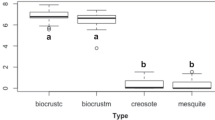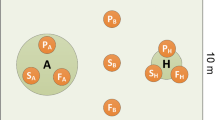Abstract
Nitrogen (N) fixation by N2-fixing bacteria (diazotrophs) is the primary N input to pristine ecosystems like boreal forests and subarctic and arctic tundra. However, the contribution by the various diazotrophs to habitat N2 fixation remains unclear. We present results from in situ assessments of N2 fixation of five diazotroph associations (with a legume, lichen, feather moss, Sphagnum moss and free-living) incorporating the ground cover of the associations in five typical habitats in the subarctic (wet and dry heath, polygon-heath, birch forest, mire). Further, we assessed the importance of soil and air temperature, as well as moisture conditions for N2 fixation. Across the growing season, the legume had the highest total as well as the highest fraction of N2 fixation rates at habitat level in the heaths (>85 % of habitat N2 fixation), whereas the free-living diazotrophs had the highest N2 fixation rates in the polygon heath (56 %), the lichen in the birch forest (87 %) and Sphagnum in the mire (100 %). The feather moss did not contribute more than 15 % to habitat N2 fixation in any of the habitats despite its high ground cover. Moisture content seemed to be a major driver of N2 fixation in the lichen, feather moss and free-living diazotrophs. Our results show that the range of N2 fixers found in pristine habitats contribute differently to habitat N2 fixation and that ground cover of the associates does not necessarily mirror contribution.





Similar content being viewed by others
References
Vitousek PM, Howarth RW (1991) Nitrogen limitation on land and in the sea: how can it occur? Biogeochem 13:87–115
Elser JJ, Bracken MES, Gruner DS, Harpole WS, Hillebrand H et al (2007) Global analysis of nitrogen and phosphorus limitation of primary producers in freshwater, marine and terrestrial ecosystems. Ecol Lett 10:1135–42
Vitousek PM, Cassman K, Cleveland C, Crews T, Field CB et al (2002) Towards an ecological understanding of biological nitrogen fixation. Biogeochem 58:1–45
Galloway JN, Dentener FJ, Capone DG, Boyer EW, Howarth RW et al (2004) Nitrogen cycles: past, present and future. Biogeochem 70:153–226
Reed SC, Cleveland CC, Townsend AR (2011) Functional ecology of free-living nitrogen fixation: a contemporary perspective. Annu Rev Ecol Evol Syst 42:489–512
Gundale MJ, DeLuca TH, Nordin A (2011) Bryophytes attenuate anthropogenic nitrogen inputs in boreal forests. Glob Change Biol 17:2743–2753
Karlsson GP, Akselsson C, Hellsten S, Karlsson PE, Malm G (2009) Övervakning av luftföroreningar norra Sverige – mätningar och moddellering. Svenska Miljöinstitut IVL rapport B1851. Lund University
DeLuca TH, Zackrisson O, Nilsson MC, Sellstedt A (2002) Quantifying nitrogen-fixation in feather moss carpets of boreal forests. Nature 419:917–920
Millbank JW, Kershaw KA (1969) Nitrogen metabolism in lichens. I. Nitrogen fixation in the cephalopodia of Peltigera aphthosa. New Phytol 68:721–729
Alexander V, Schell DM (1973) Seasonal and spatial variation of nitrogen fixation in the Barrow, Alaska, tundra. Arctic Alpine Res 5:77–88
Basilier K, Granhall U (1978) Nitrogen fixation in wet minerotrophic moss communities of a subarctic mire. Oikos 31:236–246
Smith VR (1984) Effects of abiotic factors on acetylene reduction by cyanobacteria epiphytic on moss at a subantarctic island. Appl Environ Microbiol 48:594–600
Van Cleve K, Oliver LK, Schlentner P, Viereck LA, Dyrness CT (1983) Productivity and nutrient cycling in taiga forest ecosystems. Can J For Res 13:747–766
Turetsky MR (2003) The role of bryophytes in carbon and nitrogen cycling. Bryologist 106:395–109
Michelsen A, Rinnan R, Jonasson S (2012) Two decades of experimental manipulations of heaths and forest understory in the subarctic. AMBIO 41. Suppl 3:218–230
Kurina LM, Vitousek PM (2001) Nitrogen fixation rates of Stereocaulon vulcani on young Hawaiian lava flows. Biogeochem 55:179–194
Zackrisson O, DeLuca TH, Nilsson MC et al (2004) Nitrogen fixation increases with successional age in boreal forests. Ecology 85:3327–3334
Gavazov KS, Soudzilovskaia NA, van Logtestijn RSP, Braster M, Cornelissen JHC (2010) Isotopic analysis of cyanobacterial nitrogen fixation associated with subarctic lichen and bryophyte species. Plant Soil 333:507–517
Steinberg NA, Meeks JC (1991) Photosynthetic CO2 fixation and ribulose bisphosphate carboxylase/oxygenase activity of Nostoc sp. strain UCD (7801) in symbiotic association with Anthoceros punctatus. J Bacteriol 171:6227–6233
Zielke M, Solheim B, Spjelkavik S, Olsen RA (2005) Nitrogen fixation in the high arctic: role of vegetation and environmental conditions. Arct Antarct Alp Res 37:372–378
Bay G, Nahar N, Oubre M, Whitehouse MJ, Wardle DA, Zackrisson O, Nilsson MC, Rasmussen U (2013) Boreal feather mosses secrete chemical signals to gain nitrogen. New Phytol 200:54–60
Belnap J (2002) Nitrogen fixation in biological soil cursts from southeast Utah, USA. Biol Fertil Soils 35:128–135
Simpson FB, Burris RH (1984) A nitrogen pressure of 50 atmospheres does not prevent evolution of hydrogen by nitrogenase. Science 224:1095–97
Hill S (1992) Physiology of nitrogen fixation in free-living heterotrophs. In: Stacey G, Burris RH, Evans J (eds) Biological Nitrogen Fixation. Chapman and Hall, New York, pp 87–129
Coxson DS, Kershaw KA (1983) Rehydration response of nitrogenase activity and carbon fixation in terrestrial Nostoc commune from Stipa-Bouteloua grassland. Can J Bot 61:2658–2668
DeLuca TH, Zackrisson O (2007) Enhanced soil fertility under Juniperus communis in arctic ecosystems. Plant Soil 294:147–155
Schöllhorn R, Burris RH (1967) Acetylene as a competitive inhibitor of N2 fixation. Proc Natl Acad Sci 58:213–216
Sorensen PL, Michelsen A (2011) Long-term warming and litter addition affects nitrogen fixation in a subarctic heath. Glob Change Biol 17:528–537
Sorensen PL, Jonasson S, Michelsen A (2006) Nitrogen fixation, denitrification, and ecosystem nitrogen pools in relation to vegetation development in the subarctic. Arct Antarct Alp Res 38:263–272
Lange OL, Belnap J, Reichenberger H (1998) Photosynthesis of the cyanobacterial soil-crust lichen Collema tenax from arid lands in southern Utah, USA: responses of CO2 exchange. Funct Ecol 12:195–202
Hair JF Jr, Anderson RE, Tatham RL, Back WC (1995) Multivariate data analysis. Macmillan, New York
Karagatzides JD, Lewis MC, Schulman HM (1985) Nitrogen fixation in the high arctic tundra at Scarpa Lake, northwest territories. Can J Bot 63:974–979
Gundale MJ, Gustafsson H, Nilsson MC (2009) The sensitivity of nitrogen fixation by a feather moss–cyanobacteria association to litter and moisture variability in young and old boreal forest. Can J For Res 39:2542–2549
Jackson BG, Martin P, Nilsson MC, Wardle DA (2011) Response of feather moss associated N2 fixation and litter decomposition to variations in simulated rainfall intensity and frequency. Oikos 120:570–581
Larmola T, Tuittila ES, Tiirola M, Nykänen H, Martikainen PJ, Yrjälä K et al (2010) The role of Sphagnum mosses in the methane cycling of a boreal mire. Ecology 91:2356–2365
Larmola T, Leppänen SM, Tuittila ES, Aarva M, Merilä P, Fritze H et al (2014) Methanotrophy induces nitrogen fixation during peatland development. PNAS 2:734–739
Basiliko N, Knowles R, Moore TR (2004) Roles of moss species and habitat in methane consumption potential in a northern peatland. Wetlands 24:178–185
Yeager CM, Kuske CR, Carnery TD, Johnson SL, Ticknor LO, Belnap J (2012) Response of biological soil crust diazotrophs to season, altered summer precipitation, and year-round increased temperature in an arid grassland of the Colorado Plateau, USA. Front Microbiol. doi:10.3389/fmicb.2012.00358
Rousk K, Jones DL, DeLuca TH (2014) The resilience of nitrogen fixation in feather moss (Pleurozium schreberi)-cyanobacteria associations after a drying and rewetting cycle. Plant Soil 377:159–167
Oliver MJ, Bewley JD (1984) Plant desiccation and protein synthesis. IV. RNA synthesis, stability, and recruitment of RNA into protein synthesis during desiccation and rehydration of the desiccation-tolerant moss, Tortula ruralis. Plant Physiol 74:21–25
Stewart KJ, Coxson D, Grogan P (2011) Nitrogen inputs by associative cyanobacteria across a low arctic tundra landscape. Arct Antarct Alp Res 43:267–278
Gundale MJ, Nilsson M, Bansal S, Jäderlund A (2012) The interactive effects of temperature and light on biological nitrogen fixation in boreal forests. New Phytol 194:454–463
Gundale MJ, Wardle DA, Nilsson MC (2012) The effect of altered macro-climate on N-fixation by boreal feather mosses. Biol Letters 8:805–808
Zielke M, Ekker AS, Olsen RA, Spjelkavik S, Solheim B (2002) The influence of abiotic factors on biological nitrogen fixation in different types of vegetation in the high arctic, Svalbard. Arct Antarct Alp Res 34:293–299
Lett S, Michelsen A (2014) Seasonal variation in nitrogen fixation and effects of climate change in a subarctic heath. Plant Soil 379:193–204
Pugnaire FI, Luque MT (2001) Changes in plant interactions along a gradient of environmental stress. Oikos 93:42–49
Olsen SL, Sandvik SM, Totland Ø (2013) Influence of two N-fixing legumes on plant community properties and soil nutrient levels in Alpine ecosystem. Arct Antarct Alp Res 45:363–371
Acknowledgments
We thank the Abisko Scientific Research Station for the support and supply of meteorological data. The funding of this study was provided by the Danish Council for Independent Research, the Faculty of Science at University of Copenhagen and FP7 Marie Curie Actions – COFUND (Grant ID: DFF – 1325-00025, to K.R.) and from the Danish National Research Foundation (CENPERM DNRF100, to A.M.).
Author information
Authors and Affiliations
Corresponding author
Rights and permissions
About this article
Cite this article
Rousk, K., Sorensen, P.L., Lett, S. et al. Across-Habitat Comparison of Diazotroph Activity in the Subarctic. Microb Ecol 69, 778–787 (2015). https://doi.org/10.1007/s00248-014-0534-y
Received:
Accepted:
Published:
Issue Date:
DOI: https://doi.org/10.1007/s00248-014-0534-y




